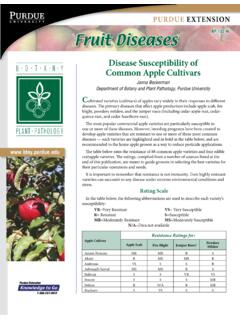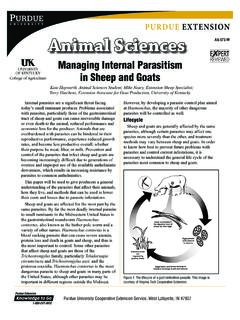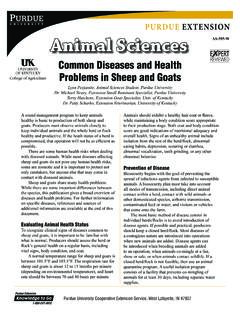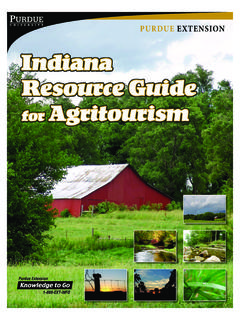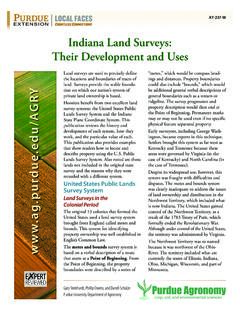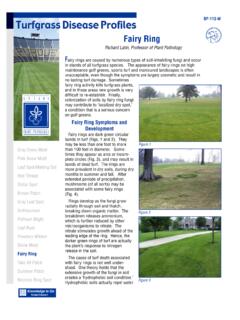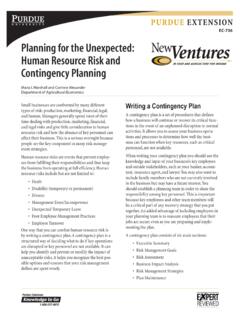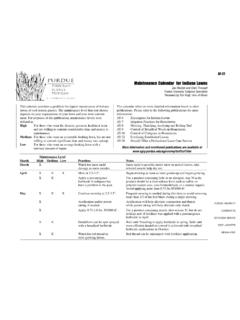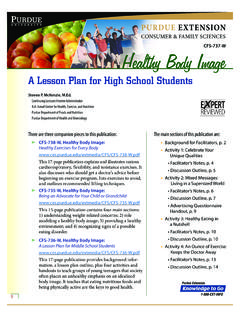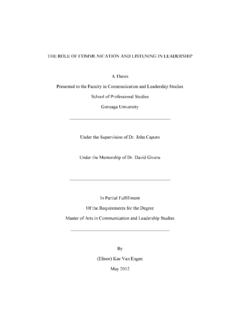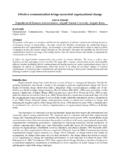Transcription of Are Newsletters Effective? Assessing Their Role as a ...
1 FNR-269-W P u r d u e e x t e n s i o n Are Newsletters effective ? Assessing Their Role as a Communication Tool Shorna Broussard and Kristin Floress Department of Forestry and Natural Resources Purdue University Newsletters have become common communication tools for many government agencies and citizen organizations. But how do you determine whether they are the best choice for every communication or education need? How can you decide if they are appropriate to use in your project? This document suggests issues to consider when using Newsletters . What a newsletter Can Do Newsletters can serve a number of purposes. They can create or increase awareness, provide basic information, or create a sense of stability and commitment for a project. However, there are few situations where a newsletter alone will accomplish a project s education goals. In situations where target audiences are motivated and have the opportunity and ability to act, a newsletter may be all that is needed1.
2 Newsletters can support and enforce educational messages as part of a larger multi-faceted effort. newsletter Limitations While Newsletters can be an effective part of a project s educational strategy, they do have certain limitations. Surveys show that people tend to scan Newsletters for interesting information bites or local news, and don t usually give them a thorough read. So, although effective at conveying new ideas or general concepts, they are probably not the best vehicle for technical or highly detailed information. That may be better presented in a bulletin, fact sheet, or a more intensive training activity, which could be mentioned in a newsletter as a source for further information. In addition, because of time constraints and production schedules, Newsletters may not be the best medium for announcing upcoming events such newsletter Tips: If you decide that a newsletter is appropriate for your project, here are some things to consider: Know Your Audience: Who are they, and what is important to them?
3 Is this information they need? Consider the Reader s Point of View: Address your audiences concerns from Their point of view, not yours. Think About How You Present Yourself: The tone of the newsletter should be professional yet friendly. Make It Look Inviting: Create a User-friendly design, avoid small and overly ornate fonts, and include relevant images where possible. Take Advantage of Existing Material: Use existing materials as a reference and a foundation for presenting new ideas and information as tours and demonstrations. An alternative is to announce those events via a simple flyer or postcard, which can be designed, printed, and distributed within a few days. Is My newsletter Working? How can you tell if your newsletter is really doing what you intended it to do? There are difficulties in thoroughly evaluating impacts of Newsletters alone, Purdue University Cooperative Extension Service, West Lafayette, IN 47907 FNR-269-W Are Newsletters Effevtive?
4 Purdue extension and the effort may not be worth the cost in time and other resources. Low response rates and challenges in defining the effects of a newsletter are but two of these obstacles. Before launching a full-blown evaluation effort, it is important to revisit your plan and think about what you are trying to accomplish. You could start by asking yourself these questions: What is this newsletter supposed to accomplish? Are these reasonable expectations? Is it reaching the right audience for its purpose? Does it adhere to good newsletter practices (see newsletter tips) Is this newsletter contributing to an educational strategy that supports the use or adoption of practices in locations that will protect or lead to improvements in water quality? Are there other more effective ways to convey this information to the appropriate audience?
5 Answers to these questions may tell you what you need to know. Issues To Consider For Evaluation Efforts designed to determine specific impacts of Newsletters tend to be research projects in Their own right. Simple approaches, such as including a tear-off card with a newsletter for readers to return, are not likely to produce a sufficient response to provide any meaningful information about the newsletter . Phone or mailed surveys pose additional challenges, can be expensive, consume staff resources, and require special expertise. Even well structured research studies face challenges in generating sufficient responses to making meaningful conclusions about a newsletter s impacts. For example, one study surveyed recipients of a newsletter for new parents an audience likely to be very motivated to act on new information and received a 43% response to Their query about the first five Newsletters and a 33% response to Their survey about the subsequent four Newsletters .
6 Generally, response rates above 60% are necessary to account for nonresponse Also, as with all self-reported data, there is a possibility that respondents could over- or under-estimate Their knowledge or behaviors, and although surveys generally assure confidentiality, respondents may tend toward more socially acceptable responses. Research that looks into behavior change as a result of reading Newsletters is limited. One study4 queried watershed groups regarding Their use of Newsletters as communication tools in watershed planning activities. While 81% of the groups surveyed used Newsletters , only 35% felt them to be effective for increasing participation in Their activities. What Are My Options? Rather than conducting a detailed study of your newsletter to determine its impacts, you could consider these approaches. Conduct a self-assessment. Compare the newsletter purpose to the information and education needs of your target audience.
7 If you don t know what those needs are, you should first focus your efforts on conducting a needs assessment. Include questions about your newsletter as part of a more comprehensive end-of-project evaluation effort. For example: Was the newsletter a useful resource for your target audience? Did the newsletter increase reader knowledge of key issues and management practices? What specifically did readers learn as a result of the newsletter ? What specifically did readers do as a result of the newsletter ? Conclusion Although Newsletters are popular and potentially useful educational communication tools, they may not always be the best choice for conveying a particular message. As a stand-alone educational device, the newsletter provides scant benefits in most situations. If a newsletter does fit an appropriate part of a communication or educational program, evaluating its effectiveness presents its own set of difficulties and concerns.
8 newsletter effectiveness is best determined as part of a comprehensive project evaluation. Purdue University Cooperative Extension Service, West Lafayette, IN 47907 This publication is printed on recycled paper using soy-based inks. P u r d u e Ag r i c u lt u r e NEW 2/07 It is the policy of the Purdue University Cooperative Extension Service, David C. Petritz, Director, that all persons shall have equal opportunity and access to the programs and facilities without regard to race, color, sex, religion, national origin, age, marital status, parental status, sexual orientation, or disability. Purdue University is an Affirmative Action institution. This material may be available in alternative formats. 1-888-EXT-INFO Purdue University Cooperative Extension Service, West Lafayette, IN 47907 3 FNR-269-W Are Newsletters Effevtive? Purdue extension For More Information Bivins, T.
9 H. (199 ). Fundamentals of successful Newsletters : Everything you need to write, design, and publish more effective Newsletters . Chicago, IL: NTC Business Books. Hamilton, (1996). newsletter design: A step-by-step guide to creative publications (design & graphic design). John Wiley & Sons. Jorgensen, L. (1999). Real-world Newsletters to meet your unreal demands. Alexandria, VA: EEI Press. 101 newsletter Answers. Accessed 5/10/06. Write a newsletter ? Who, me? Accessed 5/10/06. Notes and References 1 Rothschild, (1999). Carrots, sticks, and promises: A conceptual framework for the management of public health and social issue behaviors. Journal of Marketing, Vol. 63: 4-37. Garton, M., Hicks, K., Leatherman, M., et al. ( 003). Newsletters : treasures or trash? Parenting newsletter series results in positive behavior changes. Journal of Extension, 41.
10 Available online at Dillman, D. ( 000). Mail and internet surveys: The tailored design method. nd Edition. John Wiley & Sons. 4 Duram, & Brown, (1999). Assessing public participation in watershed planning initiatives. Society and Natural Resources, 12, 455-467 This document was developed in cooperation with the Regional Social Indicators Project Team. For additional information and contact information, visit: edu/ces/regionalwaterquality/
